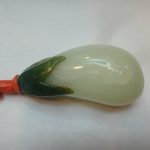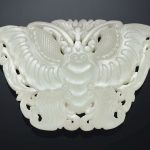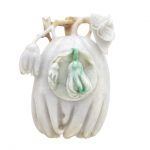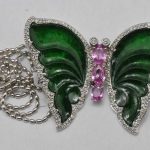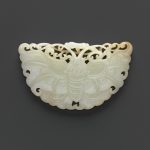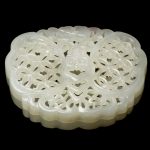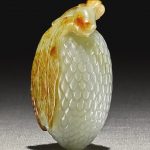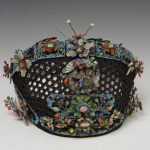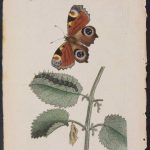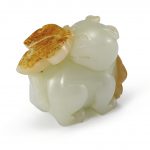Jade butterflies. Jade refers to an ornamental mineral, mostly known for its green varieties. It can refer to either of two different minerals: nephrite, a silicate of calcium and magnesium, or jadeite, a silicate of sodium and aluminium.
Jade is featured prominently in ancient Asian art, but also has an important place in many other cultures. Reference: Wikipedia
The butterfly is usually associated with joy and weddings, but as its name (hudie) is a pun for “age seventy to eighty,” it is also a symbol for longevity. Reference: The Metropolitan Museum
Below are some examples of antiques made of jade and either in the form of butterflies or decorated with butterflies.
A WHITE JADE ‘EGGPLANT’ SNUFF BOTTLE 19th century Naturalistically carved, the body made from white jade to resemble the eggplant, with a butterfly carved in low relief on the side, the calyx surrounding the mouth carved from spinach jade. 2 1/2in (6.3cm) high
Sold for US$ 4,825 (£ 3,687) inc. premium at Bonhams in 2019
A WHITE JADE ‘BUTTERFLY’ PLAQUE 18TH-19TH CENTURY The plaque is carved in openwork on each side as a stylized butterfly with finely detailed body and spread wings, with a flower above the mouth and scrolling leaves flanking the sides. The semi-translucent stone is of very pale greenish-white color. 3 1/16 (7.8 cm.) wide
Sold for USD 5,625 at Christies in 2018
Chinese Jade Citron Form Covered Bowl Carved in high relief as the fruit borne on a leafy fruiting branch with a butterfly perched on one leaf, the stone a light gray-white with apple green, chestnut and lavender inclusions. Length 4 inches.
Sold for $687 (includes buyer’s premium) at Doyle New York in 2019
18k white gold butterfly brooch, featuring jade, pink sapphires, and diamonds. Overall size is 54 x 43mm. Jade carved wings have been tested by GIA as translucent green undyed jadeite, report #2203013111. Three oval pink sapphires, largest measuring approximately 7.5 x 5 mm, smallest 5.6 x 4.2mm. Two round brilliant diamonds set into eyes, approximately 3mm each. Round briliant diamonds surround the entire border of the brooch. Total weight is 15.1 grams. Hallmarked 750.
Sold for $850 at Tremont Auctions in 2019
17th century Ming Dynasty jade butterfly
Butterfly-shaped openwork covered box Chinese Qing dynasty 19th century
Reference: Museum of Fine Arts Boston
A CELADON AND RUSSET JADE CARVING OF A LYCHEE QING DYNASTY, QIANLONG PERIOD worked in the form of a plump, succulent lychee with a smaller attendant fruit beside, both neatly worked with a layered scalp simulating the texture of the fruit, borne on a gnarled branch with a butterfly perched atop, the twigs issuing broad veined leaves wrapping around the sides of the fruit, the stone of a pale celadon tone with traces of russet patches 5.5 cm, 2 1/4 in.
Sold for 68,750 HKD at Sothebys in 2019
Headdress for a Manchu court lady. Gold openwork enriched with kingfishers feathers, pearls and semi-precious stones, mounted on a framework of black silk strengthened with wire. The headdress slopes slightly back from the forehead and widens a little towards the top; the back projects from the back of the head, presenting a flat semi-circular surface. this surface is richly decorated with a border of floral forms and two phoenixes in gold set with kingfisher feathers, surrounding a central device of a large pink stone surmounted by a butterfly with coral body and jade wings, the whole enriched with pearls set in and various semi-precious stones. In the front, the upper edge of the headdress is set with seven rectangular openwork plaques of the same style, each with a fairly large semi-precious stone in the middle, with pearl or coral enrichment. The lower part of the front surface is adorned in the same style with central device of a butterfly and flowers executed in pearls and semi-precious stones. Parts of the gold-work are slightly bent and displaced; the kingfisher feather is missing in a few places, also one or two of the stones.
Reference: © Victoria and Albert Museum

